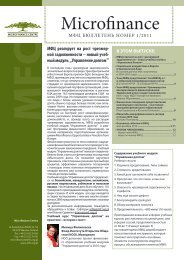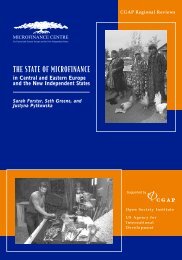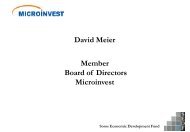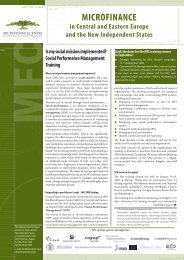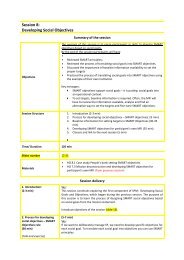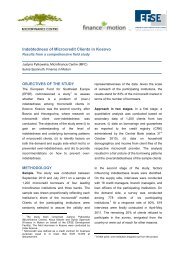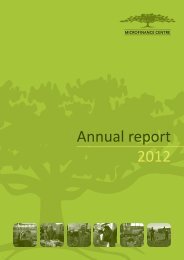Value Chains research report Tajikistan final - Microfinance Centre
Value Chains research report Tajikistan final - Microfinance Centre
Value Chains research report Tajikistan final - Microfinance Centre
Create successful ePaper yourself
Turn your PDF publications into a flip-book with our unique Google optimized e-Paper software.
In general, the wide price fluctuations give support for greenhouse production<br />
during the off season. The price for tomatoes during the season is much lower than offseason,<br />
the difference in prices historically reaching up to 2000% in some years. Table<br />
18 above (see VCA tomato), as well as Diagram 2 “Tomato Semi-Wholesale Prices in<br />
<strong>Tajikistan</strong> Regions in Somoni, 2008-2010”, show that tomato prices are at their highest<br />
from December to May. The price for greenhouse tomatoes during the last few years<br />
shows that the business could be profitable and attractive enough to justify money from<br />
the banks and MFIs, even with existing interest rates. The price during the previous<br />
season was over 2 dollars per 1 kg. This price level allows meeting the demands of the<br />
domestic market, which until recently has been supplied with Uzbek produce. Of course,<br />
given the current development of local production, it is still early to talk about complete<br />
substitution of imported tomatoes, but there is a certain positive development in this<br />
area. Indoor production of tomatoes off-season is a developing industry, and it is<br />
attractive for the farmers to invest in construction of greenhouses and switch to this<br />
crop. Price indicators show the need to use greenhouses for growing tomatoes in the<br />
winter and spring period and high profitability of this activity. However, the demand for<br />
such produce is limited by the demand of the domestic market.<br />
Specific quality standards for fresh tomatoes<br />
The main quality indicator of fresh tomatoes is that the product must be able to<br />
be stored for a long period and should have acceptable appearance. For example the<br />
tomatoes in supermarkets should be solid giving the impression of freshness.<br />
Tomatoes are divided into three categories: Extra Class, 1st Class and 2nd<br />
Class. The Extra Class Tomatoes contain the highest quality standards and capture the<br />
highest price. According to answers obtained in focus groups, tomatoes of First Class<br />
are priced 10-30% more than those of Second Class. The difference of tomato prices of<br />
Second Class and Extra Class is of 20%.<br />
Harvesting and cooling<br />
An important stage in ensuring high quality of the product is harvesting the crop, sorting<br />
and cooling. World practice shows that all efficient greenhouses are equipped with<br />
cooling stations, which allow storing tomatoes for up to ten days, thus regulating the<br />
volumes reaching the market, and export necessary amounts of produce at specific<br />
intervals, meeting the demands of the market. As a result of Uzbek entrepreneurs<br />
lacking cooling systems, much of their product was lost in the Russian market, where it<br />
was delivered without sorting and partially overripe. We need to keep this experience in<br />
mind when developing our production.<br />
Export opportunities<br />
Central Asia has some natural advantages in the greenhouse production of<br />
tomatoes in the simple fact that its latitude is more southern create a window of<br />
53




